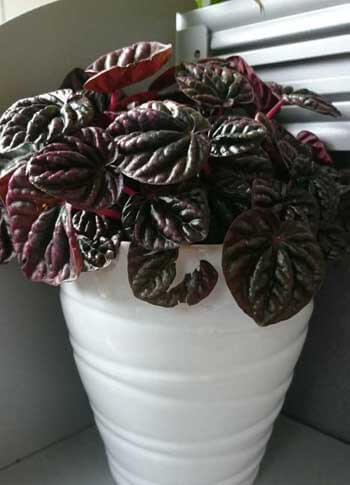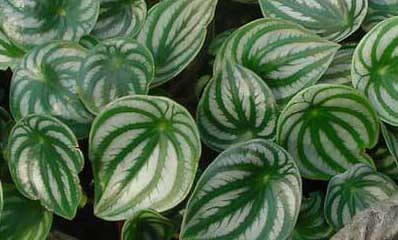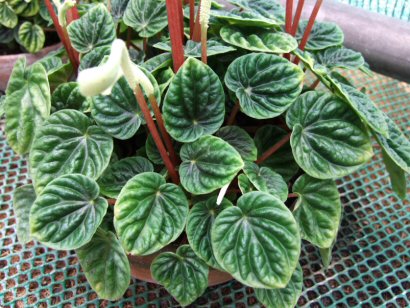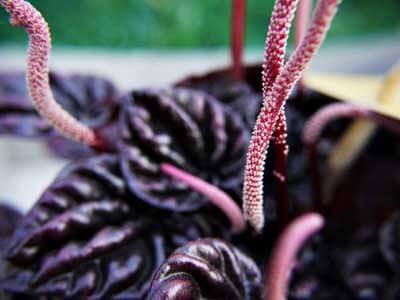





The easy going Peperomia houseplant could be a very good fit for you if you've a small space to fill in your home or office. They tend to have the reputation that they need very high levels of humidity to thrive which can put people off,  although actually this care requirement only applies to a very small number of Peperomia you can buy. In truth, providing you can keep them in a warm location, the majority of Peperomias do perfectly well in everyday homes and offices.
although actually this care requirement only applies to a very small number of Peperomia you can buy. In truth, providing you can keep them in a warm location, the majority of Peperomias do perfectly well in everyday homes and offices.
By far their greatest positive trait is the sheer number of different looking Peperomias you can buy. If you're a fan of their smaller size and easy going nature when compared to other houseplants, the diversity in looks means you've a wide choice to pick from so you're certain to find something unique that fits in perfectly with your style.
Appearance wise, Peperomia have multiple different looks from being compact and almost dainty looking to something much bolder with thick vibrant leaves. The leaves can come in different colours, shapes and textures, even the growth habit can be different from small compact rounder varieties to more tall upright types. The number of different Peperomias you can buy are vast and incredibly varied, so much so, if placed side by side you may think you're actually looking at completely different plants!
Although there are many to pick from there are some firm favorites and they'll be the ones you'll most likely to run into whilst shopping.  P. caperata (Wrinkled-leaves Peperomia) is the plant pictured at the start of this article, with wrinkled dark purple or green leaves. The compact bushy form. P. magnoliifolia (Desert Privet) has thick fleshy leaves that gives it a strong succulent looking appearance. It tends to grow taller and there is a yellow / green variegated variety that adds appeal. The very popular P. argyreia and P. sandersii (Watermelon Peperomia) have silver white and green leaf markings that resemble a watermelon again with a compact form. Finally P. scandens (Cupid Peperomia) is one of the most commonly sold trailing varieties, it's often sold in a variegated form and the leaves are shaped like hearts.
P. caperata (Wrinkled-leaves Peperomia) is the plant pictured at the start of this article, with wrinkled dark purple or green leaves. The compact bushy form. P. magnoliifolia (Desert Privet) has thick fleshy leaves that gives it a strong succulent looking appearance. It tends to grow taller and there is a yellow / green variegated variety that adds appeal. The very popular P. argyreia and P. sandersii (Watermelon Peperomia) have silver white and green leaf markings that resemble a watermelon again with a compact form. Finally P. scandens (Cupid Peperomia) is one of the most commonly sold trailing varieties, it's often sold in a variegated form and the leaves are shaped like hearts.
Light
For the most part, Peperomias are slow growing houseplants and are reasonably adaptable to the level of light you end up providing. Although if you're looking for the ideal situation, it will be one where the light levels are bright but without direct sunlight. Too much light will scorch and wash out the leaves whereas too little will eventually result in ragged, thin, and untidy growth.
Peperomias are also one of the few houseplants that do quite well from fluorescent light, so it can successfully be grown permanently in windowless rooms (provided the room light is switched on for a good part of the day of course!).
Watering
Do be careful when it comes to watering these plants as it's quite easy to over do it and create a recipe for rotting. You should look to water thoroughly and then wait until the soil has dried out a little before watering again.
Don't keep the soil constantly moist or let the soil become saturated. Equally however, Peperomias are not desert cacti so don't forget to review the situation on a regular basis and provide water when it's needed. In Winter, the plant will need very little unless it's particularly warm and bright.
Humidity
Some Peperomias do need quite high levels of humidity to maintain their pristine appearance. However the majority of Peperomias you can buy as houseplants do fine without any artificial boosts to the surrounding humidity.  The dainty leaves can be difficult to clean, so feel free to mist the leaves when it's warm to help keep them free dust.
The dainty leaves can be difficult to clean, so feel free to mist the leaves when it's warm to help keep them free dust.
Feeding
Small plants which grow slowly do not need a great deal of fertiliser and this is perfectly true here. Simply feed your plant with an all-purpose fertiliser twice a year, once in Spring and again in Summer.
Temperature
Peperomias strongly dislike cold and draughts so they can be a challenge to keep looking good in Winter if you've chosen a cool location for its home. Make things easy for yourself by keeping them in your frequently used living areas and away from unheated spare rooms. Ideally, no lower than 15°C / 59°F and for good growth during the growing seasons try to position them in a place where the temperature during the day is at or above 21°C / 70°F.
Repotting
The roots on a Peperomia are not overly adventurous so it usually take several years to fill and outgrow a pot. The roots are also quite fragile and dainty so can easily be damaged by regular repotting. You should only need to repot every two or three years at most, and when you do just use standard potting compost or a houseplant mix.
Propagation
If you're looking to propagate, it's usual to take cuttings from Peperomia plants during Spring through to late Summer and fortunately the success rate is normally high.
If you've a a tall upright or trailing type Peperomia then take stem cuttings. This is simply a piece of stem with a leaf or two attached. The stem then goes into a cutting compost which you keep moist and warm. Within a month or so, if all is well, roots will have formed and new leaves should have started to bud.
If you've a bushy Peperomia instead, then it's not practical to take stem cuttings as they tend to be very soft and just rot. So you take leaf cuttings and propagate in the same way as you do for African Violets.
Speed of Growth
All types of Peperomia are slow growing houseplants and they will take many years to outgrow the location you've chosen for your plant.
Height / Spread
There are many different types of Peperomia which have different growth patterns i.e. some are bushy and others trail, however it's unusual for the typical Peperomia to grow higher than 25cm / 10in or wider than 20cm / 8in. As mentioned this is houseplant which takes time to grow to its maximum height and spread so don't expect it to happen quickly even if the conditions you're providing are perfect.
Flowers
Peperomia's are easy going houseplants and if you meet their basic care requirements, as described above, they'll flower for you quite often.  It will depend on the type you have as to when they'll flower during the year, but it's more common for them to appear in the Summer and Autumn.
It will depend on the type you have as to when they'll flower during the year, but it's more common for them to appear in the Summer and Autumn.
The flowers don't smell and aren't particularly flashy, instead they'll more commonly be described perhaps as "quirky" with stems that grow vertically a couple of inches above the foliage below. The pink stems tend to have a slight kink in them and this together with the tiny flowers that appear, gives a look that resembles a rat or gerbil's tail. It's very unusual indeed, but at the very least if these strange flowers appear it will prove you're treating your Peperomia well! Keep it up.
Anything else?
Often these plants are considered very suitable for bottle gardens or indoor terrariums as they grow slowly, so take a long time to outgrow these homes. They can also deal reasonably well with high levels of humidity which together makes them suitable candidates.
Copyright © www.100flowers.win Botanic Garden All Rights Reserved